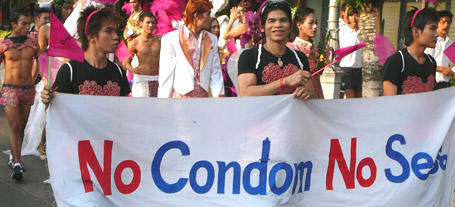With a full moon on Nov 5, both the "Bangkok Together 2006" pride parade and the Buddhist Loi Krathong festival (festival of lights) fell on the same day. "How auspicious," Bangkok people might say, as their krathongs (lo-tus-shaped vessels) floated down river, taking candles, incense and flowers in the direction of Singapore and Bali.

This year's parade was striking in the strong presence of community based NGOs - Anjaree, Sapan, Bangkok Rainbow - and the leading gay HIV/AIDS organisations - Rainbow Sky and Swing. This made the parade less commercial, over all, than in past years.
Rainbow Sky, the leading gay HIV/AIDS organisation held a seminar at the offices of the National Human Rights Commission. It focused on a challenge to the military pattern of labeling transgendered individuals as sick. The Thai who is challenging the military policy denied any illness. "I'm just a normal guy who feels like a woman," she was quoted as saying.
With the return of Tang to Bangkok, the Anjaree lesbian organisation which first started in 1986, has been reborn. Together with the Sapan group, Anjaree organised a workshop for lesbians "In or Out? Which is Better?"
The largest float in the parade was the lesbian float - with Sapan head Lek looking like a Tom (a Thai slang to mean butch lesbian) and Anjaree leader Tang dressed as a court lady. And flowers, flowers, flowers.
A Bangkok designer decided that Toms are a 'niche market' - and designed a line of special Tom clothing. Regular men's clothes, she pointed out, are not cut right for a female body. Sapan and Anjaree agreed. They organised a Tom fashion show at the annual Pride in the Park event, showing the new fashions. It competed with the male swimtrunk contest. Males crowded around the swimming pool - and females around the entertainment stage.
Old Thai hands had said in the 1990s that a pride parade was impossible in Thailand. Yes, Thais did not get upset about sexual matters. But the price of tolerance was a comfortable closet. As Tang put it, lesbians had been satisfied to be accepted and had accepted to be silent.
The assumption was that no gay Thai would show up to a pride parade - even as part of the sidewalk audience. This common wisdom was challenged by Pakorn. He was a dancer with links back to pioneer activist Natee, whose White Line Dancers did AIDS education in the bars in the 1980s. Pakorn, with his entertainment friends and support from a couple of gay businesses, held the first parade in 1999.
Police did no traffic control for the first parade, and stopped it near the end, confiscating costumes. No media noticed the police action, so the parade was seen as a big success. Negotiations with the police were still difficult over the next couple of years.
This year, as is now the pattern, police were there to block a lane of traffic and guide the parade through its full circle route in the main business and bar area of downtown Bangkok. Businesses were happy. Soi 4, with its bars and restaurants, was packed after the parade.
The parade has always had a strong commercial component. For the last few years the driving force has been Lee, originally from the US, the owner of Telephone Bar, a Bangkok gay institution. But there were tensions and a drop in membership in the organisation. At the beginning of 2006, a board meeting decided that leadership would shift from Lee and other farang (foreign) business owners to Thai organisations. But it was unclear who would take the lead. In the end it seems to have been a combination of Thai NGOs and Thai owned businesses.
The 2006 Pride Festival poster lists an amazing 62 sponsoring organisations. Corporate sponsors ranged from Singha beer and Fridae. A leading role was assumed by the Beach Group, which now runs three saunas, a residence, a bar and restaurant. Its head is Danny the Beach (who often calls himself Danny the Bitch). In the parade Danny sat like the Pope on a high throne bestowing blessings. Unlike the Pope, he had beautiful kathoey (ladyboy) attendants.
This year's parade was striking in the strong presence of community based NGOs - Anjaree, Sapan, Bangkok Rainbow - and the leading gay HIV/AIDS organisations - Rainbow Sky and Swing. This made the parade less commercial, over all, than in past years.
There are still a limited number of community-based organisations in Bangkok. There seem no university LGBT groups, and none were in the parade.
There were no allies. Amnesty International Thailand was not involved in any Pride Festival events, nor was the regional human rights group Forum Asia. Amnesty in the Philippines, in contrast, has been very active over time in Manila pride. Women's groups were not there. The only ally was the National Human Rights Commission, which for the second time sponsored an event organised by Rainbow Sky at its offices.
Unlike the current pattern for the big Western pride parades, no politicians or political parties were represented. Even without the military coup of Sep 18, there would have been no politicians or party representatives. We aren't that respectable yet.
There were no celebrity entertainers, though some in Thailand are gay - at least everybody says so. No national figures are "out" in the magic Kingdom. But we keep being told that "everyone knows" that _____ and _____ are gay. A senior civil servant once casually commented that Thailand has had two gay prime ministers. Some, only half-jokingly, expressed surprise, saying the real number was three.
No allies joined us on the streets, but the bar boys were cute and the kathoeys were gorgeous.
Douglas Sanders is a retired Canadian law professor living in Bangkok. He can be contacted at sanders_gwb@yahoo.ca

